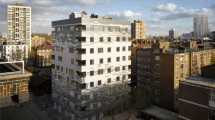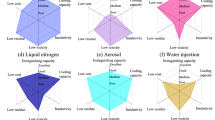The paper presents the results of experimental investigations of the main characteristics of a typical indoor seat of fire at the stages of initiating the ignition of combustible materials and in the process of their burning. Wood material, wood fiberboard, linoleum, and plastic panels have been used as combustible materials. We registered the characteristics of the seat of fire, viz., the temperature in the zone of burning of combustible materials, the times of termination of their flame combustion, and thermal decomposition, the concentrations of gaseous products of pyrolysis and combustion of these materials. The possibility of indentifying the material dominating in the seat of fire has been substantiated. Reliable identification of such material makes it possible to optimize the process of suppressing the seat of fire.
Similar content being viewed by others
References
G. P. Araujo Lima et al., Exploratory analysis of fire statistical data and prospective study applied to security and protection systems, Int. J. Disast. Risk Reduct., 61, Article ID 102308 (2021).
N. N. Brushlinsky, M. Ahrens, and S. V. Sokolov, World Fire Statistics, Berlin (2020).
I. V. Kachanov, V. V. Veremenyuk, I. V. Karpenchuk, and S. Y. Pavlyukov, Possibility of increasing the fire-suppression efficiency of the foam in automatic extinguishing installations, J. Eng. Phys. Thermophys., 86, No. 3, 525–533 (2013).
I. I. Polevoda, I. V. Karpenchuk, M. Y. Striganova, and É. É. Shatilo, Model of turbulent flow of rheological solutions of foaming agents in channels of automatic fire-extinguishing systems, J. Eng. Phys. Thermophys., 88, No. 1, 224–229 (2015).
X. Zhang, Z. Zhang, G. Su, F. Tang, A. Liu, and H. Tao, Experimental study on thermal hazard and facade flame characterization induced by incontrollable combustion of indoor energy usage, Energy, 207, Article ID 118173 (2020).
R. Qin, A. Zhou, C. L. Chow, and D. Lau, Structural performance and charring of loaded wood under fire, Eng. Struct., 228, Article ID 111491 (2021).
J. Schmid, D. Brandon, N. Werther, and M. Klippe, Technical note –– Thermal exposure of wood in standard fire resistance tests, Fire Safety J., 107, 179–185 (2019).
Z. Zhou, Y. Wei, H. Li, R. Yuen, and W. Jian, Experimental analysis of low air pressure influences on fire plumes, Int. J. Heat Mass Transf., 70, 578–585 (2014).
S. V. Puzach and E. S. Abakumov, Modified zonal model for calculating the thermodynamics of the gas in a fire within an atrium, J. Eng. Phys. Thermophys., 80, No. 2, 298–303 (2007).
R. M. Tatsii and O. Y. Pazen, Direct (classical) method of calculation of the temperature field in a hollow multilayer cylinder, J. Eng. Phys. Thermophys., 91, No. 6, 1373–1384 (2018).
Y. Z. Li and H. Ingason, Influence of fire suppression on combustion products in tunnel fires, Fire Safety J., 97, 96–110 (2018).
F. Tamanini, A study of the extinguishment of vertical wood slabs in self-sustained burning by water spray application, Combust. Sci. Technol., 14, Issues 1–3, 1–15 (1976); doi: https://doi.org/10.1080/00102207608946741.
M. Noaki, M. A. Delichatsios, J. Yamaguchi, and Y. Ohmiya, Heat release rate of wooden cribs with water application for fire suppression, Fire Safety J., 95, 170–179 (2018).
T. O. Suoware, S. O. Edelugo, and I. C. Ezema, Impact of hybrid flame retardant on the flammability and thermomechanical properties of wood sawdust polymer composite panel, Fire Mater., 43, No. 4, 335–343 (2019).
A. Janès, A. Vignes, and O. Dufaud, Ignition temperatures of dust layers and bulk storages in hot environments, J. Loss Prevent. Process Indust., 59, 106–117 (2019).
W. D. Woolley and M. M. Raftery, Smoke and toxicity hazards of plastics in fires, J. Hazard. Mater., 1, No. 3, 215–222 (1975).
L. A. Lowden and T. R. Hull, Flammability behaviour of wood and a review of the methods for its reduction, Fire Sci. Rev., 2, No. 1, 1–19 (2013).
F. Pancawardani, D. Arini, R. P. Yunindar, M. L. Ramadhan, F. A. Imran, and Y. S. Nugroho, Analysis of water mist fire suppression systema applied on cellulose fire, Proced. Eng., 170, 344–351 (2017).
V. V. Dorokhov, G. V. Kuznetsov, G. S. Nyashina, and P. A. Strizhak, Composition of a gas and ash mixture formed during the pyrolysis and combustion of coal-water slurries containing petrochemicals, Environ. Pollut., 285, Article ID 117390 (2021).
K. Horová, T. Jána, and F. Wald, Temperature heterogeneity during travelling fire on experimental building, Adv. Eng. Software, 62–63, 119–130 (2013).
E. Garcia-Castillo, I. Paya-Zaforteza, and A. Hospitaler, Analysis of the fire resistance of timber jack arch flooring systems used in historical buildings, Eng. Struct., 243, Article ID 112679 (2021).
I. Džolev, M. Laban, and S. Draganić, Survey based fi re load assessment and impact analysis of fi re load increment on fi re development in contemporary dwellings, Safety Sci., 135, Article ID 105094 (2021).
T. Gernay and N. E. Khorasani, Recommendations for performance-based fi re design of composite steel buildings using computational analysis. J. Construct. Steel Res., 166, Aeticle ID 105906 (2020).
I. S. Voitkov, R. S. Volkov, and P. A. Strizhak, Temperature of gases in a trace of water droplets, Therm. Sci., 22, No. 1A, 335–346 (2018); doi: https://doi.org/10.2298/TSCI160302020V.
A. O. Zhdanova, R. S. Volkov, I. S. Voytkov, K. Y. Osipov, and G. V. Kuznetsov, Suppression of forest fuel thermolysis by water mist, Int. J. Heat Mass Transf., 126, 703–714 (2018).
I. S. Voitkov, G. V. Kuznetsov, and P. A. Strizhak, Studying gas temperature variation upon aerosol injection, Tech. Phys. Lett., 43, No. 3, 301–304 (2017).
I. S. Voytkov, M. V. Zabelin, O. V. Vysokomornaya, and P. A. Strizhak, Deceleration and reversal in the direction of motion of water droplets in a counterflow of combustion products of flammable liquids, Chem. Petrol. Eng., 53, No. 3, 248–254 (2017).
Author information
Authors and Affiliations
Corresponding author
Additional information
Translated from Inzhenerno-Fizicheskii Zhurnal, Vol. 96, No. 1, pp. 145–151, January–February, 2023.
Rights and permissions
Springer Nature or its licensor (e.g. a society or other partner) holds exclusive rights to this article under a publishing agreement with the author(s) or other rightsholder(s); author self-archiving of the accepted manuscript version of this article is solely governed by the terms of such publishing agreement and applicable law.
About this article
Cite this article
Zhdanova, A.O., Kopylov, N.P., Kropotova, S.S. et al. Characteristics of a Typical Indoor Seat of Fire. J Eng Phys Thermophy 96, 143–149 (2023). https://doi.org/10.1007/s10891-023-02670-8
Received:
Published:
Issue Date:
DOI: https://doi.org/10.1007/s10891-023-02670-8




